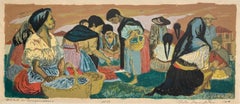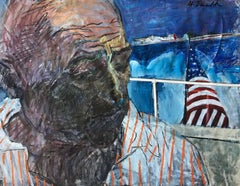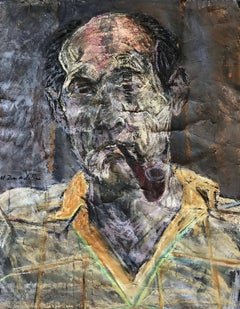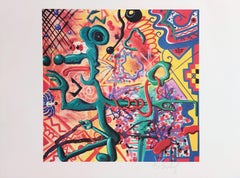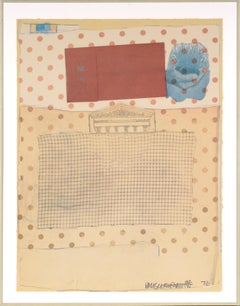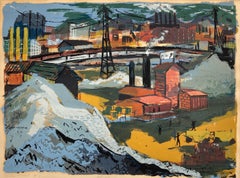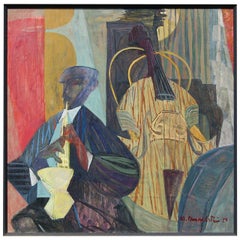Morton Dimondstein Art
to
2
1
Overall Width
to
Overall Height
to
4
1
1
2
1
1
3
2
2
1
1
1
1
1
1
3
3
3
3
1
4
10,096
2,779
1,379
1,375
4
Artist: Morton Dimondstein
MARKET IN ERONGARICUARO
By Morton Dimondstein
Located in Santa Monica, CA
MORTON DIMONDSTEIN (NY 1920 - LA 2000)
MARKET IN ERONGARICUARO 1954
Serigraph, silkscreen. Signed titled and dated in pencil. Image 10 ¼ x 25 ½ inches. Large full sheet 17 1/4 x 30...
Category
1950s American Modern Morton Dimondstein Art
Materials
Screen
PROFILE OF A WOMAN
By Morton Dimondstein
Located in Los Angeles, CA
"PROFILE OF A WOMAN"
OIL ON PANEL
C.1960
PAINTED IN ITALY
16 X 12 INCHES
Morton Dimondstein
1920-2000
At the age of seventeen Morton Dimondstein enrolled in the American Artists School and then the Art Students League in New York City, where he studied painting, drawing, and printmaking with Anton Refregier, Harry Sternberg, and Kimon Nicolaides.
After serving in the 387th Field Artillery Battalion during World War II, Dimondstein continued his studies at the Otis Art Institute in Los Angeles. He was one of the first artists to produce serigraphic prints on the West Coast, marketing them as affordable art in galleries and retail stores.
His prints and oil paintings garnered several awards during this post-war period, including an A.C.A. Gallery international competition for a one- man show in New York City.
In 1951 he moved to Mexico, where he attended the Instituto Politécnico Nacional and studied art with José Gutiérrez and David Alfaro Siqueiros. During his three years in Mexico, Dimondstein worked as a staff artist and instructor in visual education for UNESCO and was a member of the Taller de Gráfica Popular.
After moving back to Los Angeles, Dimondstein served as the art editor of the California Quarterly from 1953 to 1956. He briefly worked for the Saul Bass advertising firm where he designed books and book jackets, and collaborated on the ad campaigns for films such as William Wyler’s “The Big Country” and Otto Preminger’s “St. Joan.” Dimondstein received industry recognition for the images he created, but cranking out art for commercial ventures with strict deadlines was not for him.
He chose to leave that world in favor of working as an independent artist and art teacher. Over the years he taught at the Kann Art Institute, the New School of Art, the University of Southern California in Los Angeles, and the School of Fine Art which he established with UCLA faculty member Martin Lubner...
Category
1960s Morton Dimondstein Art
Materials
Oil, Rag Paper
PORTRAIT OF ANHALT PORTRAIOT
By Morton Dimondstein
Located in Los Angeles, CA
"PORTRAIT OF ANHALT PORTRAIOT"
FILM MAKER
OIL ON PAPER
C.1970
17.5 X 22.5 INCHES
Morton Dimondstein
1920-2000
At the age of seventeen Morton Dimondstein enrolled in ...
Category
1970s Morton Dimondstein Art
Materials
Oil, Rag Paper
$1,200 Sale Price
38% Off
PORTRAIT OF CHARLIE KELLER
By Morton Dimondstein
Located in Los Angeles, CA
"PORTRAIT OF CHARLIE KELLER"
ARTIST
OIL ON PAPER
C.1970
23 X 17.5 INCHES
Morton Dimondstein
1920-2000
At the age of seventeen Morton Dimondstein enrolled in the American Artists School and then the Art Students League in New York City, where he studied painting, drawing, and printmaking with Anton Refregier, Harry Sternberg, and Kimon Nicolaides.
After serving in the 387th Field Artillery Battalion during World War II, Dimondstein continued his studies at the Otis Art Institute in Los Angeles. He was one of the first artists to produce serigraphic prints on the West Coast, marketing them as affordable art in galleries and retail stores.
His prints and oil paintings garnered several awards during this post-war period, including an A.C.A. Gallery international competition for a one- man show in New York City.
In 1951 he moved to Mexico, where he attended the Instituto Politécnico Nacional and studied art with José Gutiérrez and David Alfaro Siqueiros. During his three years in Mexico, Dimondstein worked as a staff artist and instructor in visual education for UNESCO and was a member of the Taller de Gráfica Popular.
After moving back to Los Angeles, Dimondstein served as the art editor of the California Quarterly from 1953 to 1956. He briefly worked for the Saul Bass advertising firm where he designed books and book jackets, and collaborated on the ad campaigns for films such as William Wyler’s “The Big Country” and Otto Preminger’s “St. Joan.” Dimondstein received industry recognition for the images he created, but cranking out art for commercial ventures with strict deadlines was not for him.
He chose to leave that world in favor of working as an independent artist and art teacher. Over the years he taught at the Kann Art Institute, the New School of Art, the University of Southern California in Los Angeles, and the School of Fine Art which he established with UCLA faculty member Martin Lubner...
Category
1970s Morton Dimondstein Art
Materials
Oil, Rag Paper
$1,200 Sale Price
31% Off
Related Items
Ratfinkbonerthunk : Surrealist Rat - Original Giclee Print, Handsigned
By Kenny Scharf
Located in Paris, IDF
Kenny Scharf
Ratfinkbonerthunk : Surrealist Rat, 1990
Original Giclee Print
Handsigned in pencil
On Arches vellum 56 x 76 cm (c. 22 x 30 in)
Published by Editions Vermorel in 1990
...
Category
1990s American Modern Morton Dimondstein Art
Materials
Giclée, Screen
$1,802
H 22.05 in W 29.93 in
"Equal Justice Under Law" Screenprint #99/125 on Wove Paper
By Robert Rauschenberg
Located in Soquel, CA
"Equal Justice Under Law" Screenprint #99/125 on Wove Paper
Iconic composition by Robert Rauschenberg (American, 1925-2008). A red envelope and a hand holding sprouted grass the pli...
Category
1970s American Modern Morton Dimondstein Art
Materials
Laid Paper, Screen
$5,000
H 34 in W 26.5 in D 1.25 in
Harry Shokler, Island Harbor
By Harry Shokler
Located in New York, NY
Harry Shokler used serigraphy to great advantage in this landscape. It's colorful and detailed.
It is signed in the image at the lower left. When printmakers began making serigraphs...
Category
1940s American Modern Morton Dimondstein Art
Materials
Screen
Original Mardi Gras New Orleans 1978 festival serigraph poster
Located in Spokane, WA
Original Mardi Gras, New Orleans, 1978 linen-backed poster. Dressed up in what would be an American Indian costume with full headgear, he is holding a shield with a horse on it. Indian decoration on the footwear. Signed and numbered.
I believe this has to deal with Big Chief leading his Congo Nation Mardi Gras Indian group. Zulu Parade. Many of the original Mardi Gras jazz posters...
Category
1970s American Modern Morton Dimondstein Art
Materials
Screen
$636 Sale Price
20% Off
H 32 in W 23 in D 0.05 in
Baden Baden, Casino
By LeRoy Neiman
Located in San Francisco, CA
This artwork titled "Baden Baden, Casino" 1988 is an original color serigraph by noted American artist LeRoy Neiman, 1921-2012. It is hand signed and numbered 261/375 in pencil by the artist. The image size is 36 x 42 inches, sheet size is 42 x 48 inches. With the blind stamp of the printer Styria Studio at the lower left corner margin. It is in excellent condition, three small pieces of hanging tape remain on the back.
About the artist:
Mr. Neiman's kinetic, quickly executed paintings and drawings, many of them published in Playboy, offered his fans gaudily colored visual reports on heavyweight boxing matches, Super Bowl games and Olympic contests, as well as social panoramas like the horse races at Deauville, France, and the Cannes Film Festival.
Quite consciously, he cast himself in the mold of French Impressionists like Toulouse-Lautrec, Renoir and Degas, chroniclers of public life who found rich social material at racetracks, dance halls and cafes.
Mr. Neiman often painted or sketched on live television. With the camera recording his progress at the sketchpad or easel, he interpreted the drama of Olympic Games and Super Bowls for an audience of millions.
When Bobby Fischer and Boris Spassky faced off in Reykjavik, Iceland, to decide the world chess championship, Mr. Neiman was there, sketching. He was on hand to capture Federico Fellini directing "8 ½" and the Kirov Ballet performing in the Soviet Union.
In popularity, Mr. Neiman rivaled American favorites like Norman Rockwell, Grandma Moses and Andrew Wyeth. A prolific one-man industry, he generated hundreds of paintings, drawings, watercolors, limited-edition serigraph prints and coffee-table books yearly, earning gross annual revenue in the tens of millions of dollars.
Although he exhibited constantly and his work was included in the collections of dozens of museums around the world, critical respect eluded him. Mainstream art critics either ignored him completely or, if forced to consider his work, dismissed it with contempt as garish and superficial — magazine illustration with pretensions. Mr. Neiman professed not to care.
Maybe the critics are right," he told American Artist magazine in 1995. "But what am I supposed to do about it — stop painting, change my work completely? I go back into the studio, and there I am at the easel again. I enjoy what I'm doing and feel good working. Other thoughts are just crowded out."
His image suggested an artist well beyond the reach of criticism. A dandy and bon vivant, he cut an arresting figure with his luxuriant ear-to-ear mustache, white suits, flashy hats and Cuban cigars. "He quite intentionally invented himself as a flamboyant artist not unlike Salvador Dalí, in much the same way that I became Mr. Playboy in the late '50s," Hugh Hefner told Cigar Aficionado magazine in 1995.
LeRoy Runquist was born on June 8, 1921, in St. Paul. His father, a railroad worker, deserted the family when LeRoy was quite young, and the boy took the surname of his stepfather.
He showed a flair for art at an early age. While attending a local Roman Catholic school, he impressed schoolmates by drawing ink tattoos on their arms during recess.
As a teenager, he earned money doing illustrations for local grocery stores. "I'd sketch a turkey, a cow, a fish, with the prices," he told Cigar Aficionado. "And then I had the good sense to draw the guy who owned the store. This gave me tremendous power as a kid."
After being drafted into the Army in 1942, he served as a cook in the European theater but in his spare time painted risqué murals on the walls of kitchens and mess halls. The Army's Special Services Division, recognizing his talent, put him to work painting stage sets for Red Cross shows when he was stationed in Germany after the war.
On leaving the military, he studied briefly at the St. Paul School of Art (now the Minnesota Museum of American Art) before enrolling in the School of the Art Institute of Chicago, where, after four years of study, he taught figure drawing and fashion illustration throughout the 1950s.
When the janitor of the apartment building next door to his threw out half-empty cans of enamel house paint, Mr. Neiman found his métier. Experimenting with the new medium, he embraced a rapid style of applying paint to canvas imposed by the free-flowing quality of the house paint.
While doing freelance fashion illustration for the Carson Pirie Scott department store in Chicago in the early 1950s, he became friendly with Mr. Hefner, a copywriter there who was on the verge of publishing the first issue of a men's magazine.
In 1954, after five issues of Playboy had appeared, Mr. Neiman ran into Mr. Hefner and invited him to his apartment to see his paintings of boxers, strip clubs and restaurants. Mr. Hefner, impressed, showed the work to Playboy's art director, Art Paul, who commissioned an illustration for "Black Country," a story by Charles Beaumont about a jazz musician.
Thus began a relationship that endured for more than half a century and established Mr. Neiman's reputation.
In 1955, when Mr. Hefner decided that the party-jokes page needed visual interest, Mr. Neiman came up with the Femlin, a curvaceous brunette who cavorted across the page in thigh-high stockings, high-heeled shoes, opera gloves and nothing else. She appeared in every issue of the magazine thereafter.
Three years later, Mr. Neiman devised a running feature, "Man at His Leisure." For the next 15 years, he went on assignment to glamour spots around the world, sending back visual reports on subjects as varied as the races at Royal Ascot, the dining room of the Tour d'Argent in Paris, the nude beaches of the Dalmatian coast, the running of the bulls at Pamplona and Carnaby Street in swinging London. He later produced more than 100 paintings and 2 murals for 18 of the Playboy clubs that opened around the world.
"Playboy made the good life a reality for me and made it the subject matter of my paintings — not affluence and luxury as such, but joie de vivre itself," Mr. Neiman told V.I.P. magazine in 1962.
Working in the same copywriting department at Carson Pirie Scott as Mr. Hefner was Janet Byrne, a student at the Art Institute. She and Mr. Neiman married in 1957. She survives him.
A prolific artist, he generated dozens of paintings each year that routinely commanded five-figure prices. When Christie's auctioned off the Playboy archives in 2003, his 1969 painting Man at His Leisure: Le Mans sold for $107,550. Sales of the signed, limited-edition print versions of his paintings, published in editions of 250 to 500, became a lucrative business in itself after Knoedler Publishing, a wholesale operation, was created in 1975 to publish and distribute his serigraphs, etchings, books and posters.
Mr. Neiman's most famous images came from the world of sports. His long association with the Olympics began with the Winter Games in Squaw Valley in 1960, and he went on to cover the games, on live television, in Munich in 1972, Montreal in 1976, Lake Placid in 1980, and Sarajevo and Los Angeles in 1984, using watercolor, ink or felt-tip marker to produce images with the dispatch of a courtroom sketch artist. At the 1978 and 1979 Super Bowls, he used a computerized electronic pen to portray the action for CBS.
Although he was best known for scenes filled with people and incident, he also painted many portraits. Athletes predominated, with Muhammad Ali and Joe Namath among his more famous subjects, but he also painted Leonard Bernstein, the ballet dancer Suzanne Farrell...
Category
21st Century and Contemporary American Modern Morton Dimondstein Art
Materials
Screen
Neruda's Friend - Oil Paint by Luigi Granetto - 1998
Located in Roma, IT
Oil on paper realized by Luigi Granetto in 1998.
Hand signed.
Includes a wooden frame realized by the artist cm. 45x38.5
Category
1980s Contemporary Morton Dimondstein Art
Materials
Oil, Paper
$456
H 9.85 in W 7.29 in D 0.4 in
Spanish school. Secretary of Pope Pius V, abbot of Husillos, bishop of Córdoba.
Located in Firenze, IT
Portrait of Francisco de Reynoso y Baeza.
Secretary of Pope Pius V, abbot of Husillos and bishop of Córdoba. Francisci de Reynoso.
Early 17th century.
Small-format portrait from the late Renaissance period.
Spanish school.
Size: Cm 19 x Cm 13.5
Oil on wooden panel.
On the back the fine tablet is strengthened (already in ancient times) by a sheet of parchment.
About 1600-1610.
As often in Mannerist / Late Renaissance portraits, the image of the character is accompanied by the writing that runs at the top, adding a celebratory, historicising touch to the effigy. Let's bring back the sentence here:
DON FRANCISCO DE REINOSO. CAMARERO SECRETO IESCALCO PIO QUINTO OBISCOPO CORDOBA. 68 (? O 7?)
(1534, Autillo de Campos, Spain - 1601, Córdoba)
Francisco de Reynoso was a Spanish cleric, chief chamberlain, and secretary to Pope Pius V, abbot of Husillos, and bishop of Córdoba.
He was the fourth of eleven children. His father was the seventh Lord of Autillo de Campos, and his mother was Juana de Baeza y de las Casas, daughter of Manuel de Baeza, a lawyer of the Royal Council and at the Court of Valladolid.
Francisco de Reynoso was deeply devoted to the Virgin Mary and showed a strong inclination toward religion and piety from an early age.
He studied Latin, arts, and theology at the University of Salamanca.
In 1562, he traveled to Rome with his brothers Pedro and Luis.
In January 1566, following the death of Pope Pius IV, Cardinal Antonio Michele Ghislieri was elected pope, becoming Pius V. From this period until Ghislieri's death in 1572, Francisco de Reynoso served as his chief chamberlain and secretary.
After Pope Pius V died, Francisco de Reynoso returned to Spain and lived for several years in the city of Palencia, where his brother Manuel was a canon.
He supported the Society of Jesus when it was established in Palencia, providing alms to the school's clergy and funding chairs of Letters and Theology at his own expense, as well as donating a significant number of books.
During the brief outbreak of the Black Plague...
Category
17th Century Old Masters Morton Dimondstein Art
Materials
Parchment Paper, Oil, Wood Panel
$1,538 Sale Price
20% Off
H 7.49 in W 5.32 in
"Balcony" 1938 WPA Print Mid 20th Century American Broadway Theatre Modernism
By Leon Bibel
Located in New York, NY
"Balcony" 1938 WPA Print Mid 20th Century American Broadway Theatre Modernism.
Silk screen on paper, 15” x 20". Numbered 15/20 lower left. Pencil si...
Category
1930s American Modern Morton Dimondstein Art
Materials
Paper, Screen
Left Bank Cafe, Paris
By LeRoy Neiman
Located in San Francisco, CA
This artwork titled "Left Bank Cafe, Paris" 1987 is an original color serigraph by noted American artist LeRoy Neiman, 1921-2012. It is hand signed and numbered H.C 166/175 in pencil by the artist. The image size is 26 x 38 inches, sheet size is 32.25 x 44 inches. With the blind stamp of the printer Styria Studio at the lower left corner margin. It is in excellent condition, two small pieces of hanging tape remain on the back.
About the artist:
Mr. Neiman's kinetic, quickly executed paintings and drawings, many of them published in Playboy, offered his fans gaudily colored visual reports on heavyweight boxing matches, Super Bowl games and Olympic contests, as well as social panoramas like the horse races at Deauville, France, and the Cannes Film Festival.
Quite consciously, he cast himself in the mold of French Impressionists like Toulouse-Lautrec, Renoir and Degas, chroniclers of public life who found rich social material at racetracks, dance halls and cafes.
Mr. Neiman often painted or sketched on live television. With the camera recording his progress at the sketchpad or easel, he interpreted the drama of Olympic Games and Super Bowls for an audience of millions.
When Bobby Fischer and Boris Spassky faced off in Reykjavik, Iceland, to decide the world chess championship, Mr. Neiman was there, sketching. He was on hand to capture Federico Fellini directing "8 ½" and the Kirov Ballet performing in the Soviet Union.
In popularity, Mr. Neiman rivaled American favorites like Norman Rockwell, Grandma Moses and Andrew Wyeth. A prolific one-man industry, he generated hundreds of paintings, drawings, watercolors, limited-edition serigraph prints and coffee-table books yearly, earning gross annual revenue in the tens of millions of dollars.
Although he exhibited constantly and his work was included in the collections of dozens of museums around the world, critical respect eluded him. Mainstream art critics either ignored him completely or, if forced to consider his work, dismissed it with contempt as garish and superficial — magazine illustration with pretensions. Mr. Neiman professed not to care.
Maybe the critics are right," he told American Artist magazine in 1995. "But what am I supposed to do about it — stop painting, change my work completely? I go back into the studio, and there I am at the easel again. I enjoy what I'm doing and feel good working. Other thoughts are just crowded out."
His image suggested an artist well beyond the reach of criticism. A dandy and bon vivant, he cut an arresting figure with his luxuriant ear-to-ear mustache, white suits, flashy hats and Cuban cigars. "He quite intentionally invented himself as a flamboyant artist not unlike Salvador Dalí, in much the same way that I became Mr. Playboy in the late '50s," Hugh Hefner told Cigar Aficionado magazine in 1995.
LeRoy Runquist was born on June 8, 1921, in St. Paul. His father, a railroad worker, deserted the family when LeRoy was quite young, and the boy took the surname of his stepfather.
He showed a flair for art at an early age. While attending a local Roman Catholic school, he impressed schoolmates by drawing ink tattoos on their arms during recess.
As a teenager, he earned money doing illustrations for local grocery stores. "I'd sketch a turkey, a cow, a fish, with the prices," he told Cigar Aficionado. "And then I had the good sense to draw the guy who owned the store. This gave me tremendous power as a kid."
After being drafted into the Army in 1942, he served as a cook in the European theater but in his spare time painted risqué murals on the walls of kitchens and mess halls. The Army's Special Services Division, recognizing his talent, put him to work painting stage sets for Red Cross shows when he was stationed in Germany after the war.
On leaving the military, he studied briefly at the St. Paul School of Art (now the Minnesota Museum of American Art) before enrolling in the School of the Art Institute of Chicago, where, after four years of study, he taught figure drawing and fashion illustration throughout the 1950s.
When the janitor of the apartment building next door to his threw out half-empty cans of enamel house paint, Mr. Neiman found his métier. Experimenting with the new medium, he embraced a rapid style of applying paint to canvas imposed by the free-flowing quality of the house paint.
While doing freelance fashion illustration for the Carson Pirie Scott department store in Chicago in the early 1950s, he became friendly with Mr. Hefner, a copywriter there who was on the verge of publishing the first issue of a men's magazine.
In 1954, after five issues of Playboy had appeared, Mr. Neiman ran into Mr. Hefner and invited him to his apartment to see his paintings of boxers, strip clubs and restaurants. Mr. Hefner, impressed, showed the work to Playboy's art director, Art Paul, who commissioned an illustration for "Black Country," a story by Charles Beaumont about a jazz musician.
Thus began a relationship that endured for more than half a century and established Mr. Neiman's reputation.
In 1955, when Mr. Hefner decided that the party-jokes page needed visual interest, Mr. Neiman came up with the Femlin, a curvaceous brunette who cavorted across the page in thigh-high stockings, high-heeled shoes, opera gloves and nothing else. She appeared in every issue of the magazine thereafter.
Three years later, Mr. Neiman devised a running feature, "Man at His Leisure." For the next 15 years, he went on assignment to glamour spots around the world, sending back visual reports on subjects as varied as the races at Royal Ascot, the dining room of the Tour d'Argent in Paris, the nude beaches of the Dalmatian coast, the running of the bulls at Pamplona and Carnaby Street in swinging London. He later produced more than 100 paintings and 2 murals for 18 of the Playboy clubs that opened around the world.
"Playboy made the good life a reality for me and made it the subject matter of my paintings — not affluence and luxury as such, but joie de vivre itself," Mr. Neiman told V.I.P. magazine in 1962.
Working in the same copywriting department at Carson Pirie Scott as Mr. Hefner was Janet Byrne, a student at the Art Institute. She and Mr. Neiman married in 1957. She survives him.
A prolific artist, he generated dozens of paintings each year that routinely commanded five-figure prices. When Christie's auctioned off the Playboy archives in 2003, his 1969 painting Man at His Leisure: Le Mans sold for $107,550. Sales of the signed, limited-edition print versions of his paintings, published in editions of 250 to 500, became a lucrative business in itself after Knoedler Publishing, a wholesale operation, was created in 1975 to publish and distribute his serigraphs, etchings, books and posters.
Mr. Neiman's most famous images came from the world of sports. His long association with the Olympics began with the Winter Games in Squaw Valley in 1960, and he went on to cover the games, on live television, in Munich in 1972, Montreal in 1976, Lake Placid in 1980, and Sarajevo and Los Angeles in 1984, using watercolor, ink or felt-tip marker to produce images with the dispatch of a courtroom sketch artist. At the 1978 and 1979 Super Bowls, he used a computerized electronic pen to portray the action for CBS.
Although he was best known for scenes filled with people and incident, he also painted many portraits. Athletes predominated, with Muhammad Ali and Joe Namath among his more famous subjects, but he also painted Leonard Bernstein, the ballet dancer Suzanne Farrell...
Category
21st Century and Contemporary American Modern Morton Dimondstein Art
Materials
Screen
The strategist -Timothy Archer, 21st Century, Contemporary painting
By Timothy Archer
Located in Paris, FR
Oil paint and pastel on paper
Signed and dated lower left by the artist
Category
2010s Contemporary Morton Dimondstein Art
Materials
Paper, Oil Pastel, Oil
$5,168
H 47.25 in W 31.5 in
Flowers - Original Screen Print - Handsigned and /100 (Schellman II.101)
By Andy Warhol
Located in Paris, IDF
Andy Warhol (1928-1987)
Flowers (black and white), 1986
Original silkscreen (Printer Alexander Heinrichi, New York)
Signed in pencil with the monogram lower right
Countersigned in p...
Category
1980s American Modern Morton Dimondstein Art
Materials
Screen
$10,817
H 40.56 in W 27.17 in
Stewart Wheeler, Atlantic City (New Jersey)
Located in New York, NY
The little that is know about the painter and printmaker Stewart Wheeler indicates that most of his career was spent in Philadelphia, Pennsylvania. And...
Category
Mid-20th Century American Modern Morton Dimondstein Art
Materials
Screen
Previously Available Items
Industrial # 2
By Morton Dimondstein
Located in Santa Monica, CA
MORTON DIAMONDSON ((1920 - 2000)
INDUSTRIAL # 2, 1947
Serigraph. image, 11 1/4 x 15 1/2 inches Sheet 15 x 21 inches. Signed and titled on pencil. Mat burn surrounding the image in...
Category
1940s Modern Morton Dimondstein Art
Materials
Screen
The Jazz Soloist
By Morton Dimondstein
Located in Wiscasett, ME
Oil on canvas, signed and dated 1959
35” x 35”
Morton Dimondstein was born in New York in 1920 and at the age of seventeen, studied art at the American Artists School and then at the...
Category
1950s Cubist Morton Dimondstein Art
Materials
Oil
The Three Graces
By Morton Dimondstein
Located in Soquel, CA
Beautiful bronze sculpture with dark patina titled "Three Graces" by Morton Dimondstein. Size approximately 12"D X 14"H X 16"L. Add 4" for wood base. Unsigned. Titled and dated (Ame...
Category
1960s Abstract Expressionist Morton Dimondstein Art
Materials
Bronze
PORTRAIT OF MARTIN LUBNER
By Morton Dimondstein
Located in Los Angeles, CA
"PORTRAIT OF MARTIN LUBNER"
OIL ON CANVAS, SIGNED
DATED 1967
27 X 22 INCHES
Morton Dimondstein
1920-2000
At the age of seventeen Morton Dimondstein...
Category
1960s Expressionist Morton Dimondstein Art
Materials
Canvas, Oil
PORTRAIT OF JANET STEVENSON
By Morton Dimondstein
Located in Los Angeles, CA
"PORTRAIT OF JANET STEVENSON"
OIL ON CANVAS, SIGNED
DATED 1958
30 X 24 INCHES
Morton Dimondstein
1920-2000
At the age of seventeen Morton Dimondstein enrolled in the American A...
Category
1950s Expressionist Morton Dimondstein Art
Materials
Canvas, Oil
PORTRAIT OF MARTIN LUBNER PAINTING
By Morton Dimondstein
Located in Los Angeles, CA
"PORTRAIT OF MARTIN LUBNER PAINTING"
OIL ON PANEL, SIGNED
DATED 1958
31 X 29.5 INCHES
Morton Dimondstein
1920-2000
At the age of seventeen Morton D...
Category
1950s Expressionist Morton Dimondstein Art
Materials
Canvas, Oil
PORTRAIT OF DAVID AND FRANKIE LEMON
By Morton Dimondstein
Located in Los Angeles, CA
"PORTRAIT OF DAVID AND FRANKIE LEMON"
ARTISTS
OIL ON PAPER
C.1970
20.5 X 26 INCHES
Morton Dimondstein
1920-2000
At the age of seventeen Morton Dimondstein enrolled ...
Category
1970s Expressionist Morton Dimondstein Art
Materials
Oil, Rag Paper
Portrait of Manny
By Morton Dimondstein
Located in Los Angeles, CA
"MANNY"
FRIEND
OIL ON PANEL
C.1950S
9.5 X 8 INCHES
Morton Dimondstein
1920-2000
At the age of seventeen Morton Dimondstein enrolled in the American Artists School and then the...
Category
1960s Morton Dimondstein Art
Materials
Oil, Panel
PORTRAIT OF A MAN
By Morton Dimondstein
Located in Los Angeles, CA
"PORTRAIT OF A MAN"
OIL ON PANEL
C.1960
PAINTED IN ITALY
15 X 11 INCHES
Morton Dimondstein
1920-2000
At the age of seventeen Morton Dimondstein enrolled in the American Artist...
Category
1960s Expressionist Morton Dimondstein Art
Materials
Oil, Panel
Geraldine
By Morton Dimondstein
Located in Los Angeles, CA
"GERALDINE"
OIL ON PANEL
THE ARTIST'S WIFE
C.1960
13 X 24 Inches
Morton Dimondstein
1920-2000
At the age of seventeen Morton Dimondstein enrolled in the American Artists Schoo...
Category
1960s Expressionist Morton Dimondstein Art
Materials
Oil, Panel
Still Life
By Morton Dimondstein
Located in Los Angeles, CA
MORTON DIMONDSTEIN
"STILL LIFE"
OIL ON CANVAS, SIGNED
AMERICAN, C.1960, PAINTED IN ROME
21.5 X 25.25 INCHES
Morton Dimondstein
1920-2000
At the age of seventeen ...
Category
1960s Modern Morton Dimondstein Art
Materials
Canvas, Oil
The Artist at Work
By Morton Dimondstein
Located in Los Angeles, CA
"THE ARTIST AT WORK"
OIL ON CANVAS, ESTATE STAMPED
C.1960
31.5 X 29 INCHES
Morton Dimondstein
1920-2000
At the age of seventeen Morton Dimondstein...
Category
1950s American Modern Morton Dimondstein Art
Materials
Canvas, Oil
Morton Dimondstein art for sale on 1stDibs.
Find a wide variety of authentic Morton Dimondstein art available for sale on 1stDibs. You can also browse by medium to find art by Morton Dimondstein in oil paint, paint, paper and more. Customers who are interested in this artist might also find the work of Charles Quest, Tarmo Pasto, and Ruth Gikow. Morton Dimondstein art prices can differ depending upon medium, time period and other attributes. On 1stDibs, the price for these items starts at $950 and tops out at $1,200, while the average work can sell for $1,200.
